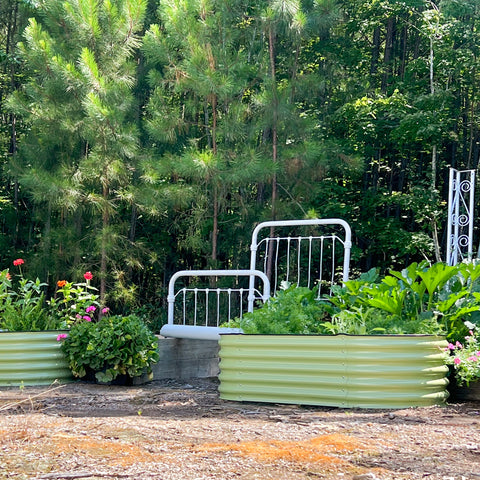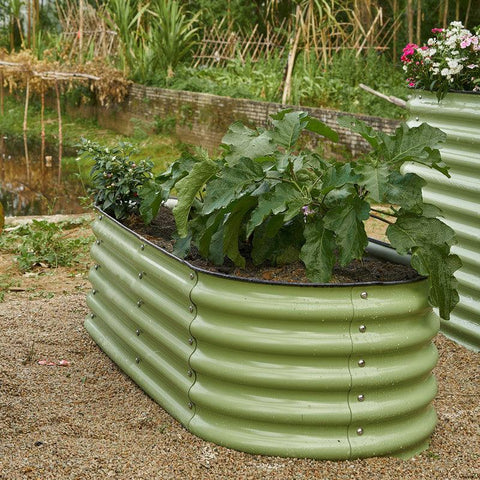Tips from Olle Garden Bed: 4 Good Ways To Harvest Potatoes And Store Them for Winter
Harvesting potatoes is much easier than you think. After all, there is a reason why these delicious tubers are loved around the world. They are easy to plant, easy to dig, and very durable in storage. Read on to learn how to dig out your potatoes and how to keep them fresh and delicious throughout the winter. The following content also has some reference value for raised garden beds.
Everything you need to know about harvesting potatoes
In the past, potato planting mainly occurred in the field or in straw bags. Growing up on my grandparents' farm, I have fond memories of harvesting potatoes. Usually, when I stand on the warm land barefoot, my grandfather will carefully dig out the plants, and then my job is to dig.
I like this annual ceremony. I never knew how much I would find, or how big they would be. Maybe this is part of the temptation. I think everyone else is happy not to crawl around in the mud.
Since the rise of urban and small space gardening, people have come up with various ingenious ways to grow these potatoes.

When to harvest
First, let's see when the best harvest time is. For winter storage, let your plants and weather decide when you should start collecting. Potatoes can handle a little frost, but you definitely want to get them out before you expect any severe frost.
You can harvest confidently at any time after the top of the vine turns brown. If you have no frost, please harvest before the soil temperature drops below 45F (7C).
Start with a small "test" section. If the potato skin is too easy to wipe off, your potato is too new. Therefore, they need to stay on the earth for a few more days to mature. However, your test potatoes will make a delicious meal, so nothing will be wasted.
Different planting and harvesting methods
Now that you have completed the test and are sure that your potatoes are ripe, please continue reading to understand the best harvest method for each planting method.
Trench and pile method
Trench piling is a classical method for potato planting. In other words, it needs the most space and is very labor-intensive. However, harvesting potatoes is a particularly rewarding experience (although I may be biased).
First, loosen the roots of the plant so that you can pull it out and into the potato below. You can use a shovel, fork, or hand. Be careful when using large tools, because seriously damaged potatoes will rot in storage.
Give plants a wide berth and sink the shovel as deep as possible. Then lift the roots with a shovel and plant. Then you can go in and start digging the rest with your hands.

Container planting
With the development of urban gardening, container planting has become more and more popular. More and more people realize that gardening is not out of reach after all. Although you can't expect to be as productive as someone with a large garden, the rewards are still there. Most importantly, it is much easier to obtain these potatoes.
It only takes a fork to break the soil around the plant. This may cause some confusion, but you can also simply turn over the container and filter the dirt by hand.
If you are not so keen on creating a big mess that needs cleaning up, breaking the soil and sifting potatoes by hand is also a good way to extract potatoes. Having an empty container nearby for dead plants can also keep chaos to a minimum.
Bag
This is a good choice for those who have shorter space and want to use as much vertical space as possible. For people like me who do not want dust to spill out of the balcony, it is better to harvest on barrels or other containers.
You can simply cut the bottom of the sack and let the potatoes roll out. Even if the bottom is cut, these bags can be reused in the next season. Just sew the bottom with some good thick thread, and they can do another round.
Straw
This was a very popular method in the past. In addition, planting potatoes in straw is a good way to reconnect with ancestors. If there is only a thin layer of soil around your house, this is also an ideal choice. The seed fragments are planted on the soil surface, so no excavation is required. This method also makes harvesting very easy.
You don't need any tools except your own hands. Just pull the hay away from the plant and retrieve the potatoes. Easy to do! Since you often water this hay, please throw all the potatoes directly into the compost after they are taken out.
Harvest new potatoes
There's no reason why you can't just pull a few potatoes at dinner. These young potatoes can be pulled up two to three weeks after the plants stop flowering, which is a delicious midsummer treat. Just be careful not to damage the plants. You should also ensure that you eat anything you pick up within a few days.
If your crops are underground, or even in containers, use a shovel or fork to pull back some topsoil. Then dig down with your hands to recover a few potatoes. If you use a bag, just put your hand into the sack and pull it out for a couple to eat.
The straw is probably the simplest, because you just have to pull back some straw and replace it. Make sure to provide good watering for your plants after taking the required substances and covering the remaining roots. This will counteract any minor trauma caused by the interference.
Store potatoes for winter
Prepare to refrigerate
Your potatoes need to be dried or "cured" before they can be stored. If possible, keep them in a cool, dry place for up to two weeks. Curing can thicken their skin, which helps them stay longer during winter storage. Remove and cook anything that is slightly damaged. These will not cure properly and may cause your entire harvest to rot in storage.

Cold cellar storage
A small amount of humidity is OK, even beneficial, but your potatoes should not be affected with moisture. They prefer a cool environment around 38 – 40F (3-4C). Gently brush away dirt, but do not wash them. This will shorten their retention time.
Like many people in their generation, my grandparents had a cold cellar in their basement. This is where potatoes and other root vegetables are stored on raised wooden platforms and shelves. The potatoes are spread on the burlap, with a layer of sand on top.
Nowadays, the earth floor of the basement is rare, but even the unfinished basement with concrete floor and walls can be used as a storage room as long as it is cool and dark. Just be careful to keep the vegetables away from the concrete.
If you want to store multiple vegetables together, make sure the apples are in your storage area. The ethylene gas they release can cause your potatoes (and possibly everything else) to rot.
Refrigeration of modern gardeners
Unfortunately, the choice of modern lifestyle means that few people can enter the cold cellar. Since we know that the ideal temperature range is 38-40F (3-4C), we can propose some DIY refrigeration options.
If you have a closed porch that is cold but not below freezing, and even a closet on the wall facing outward, you may be lucky.
An old dresser can be placed on a closed porch to accommodate several root vegetables separated by drawers. Wrapping potatoes in burlap and placing them in the coolest dark corner of the exterior closet can also produce positive results.
Just make sure to periodically check the experimental storage. I keep my regular potatoes in the kitchen drawer. Believe me, forgetting one and "discovering" it in a few months is not something that everyone will like. If you find a potato is beginning to deteriorate, please remove it immediately. The decay will quickly spread to the rest of the lot.
Summer in the northern hemisphere is coming to an end, which means harvest time is coming. I hope this article will excite you to dig out those beautiful big potatoes.
Happy digging, even a happier diet!
